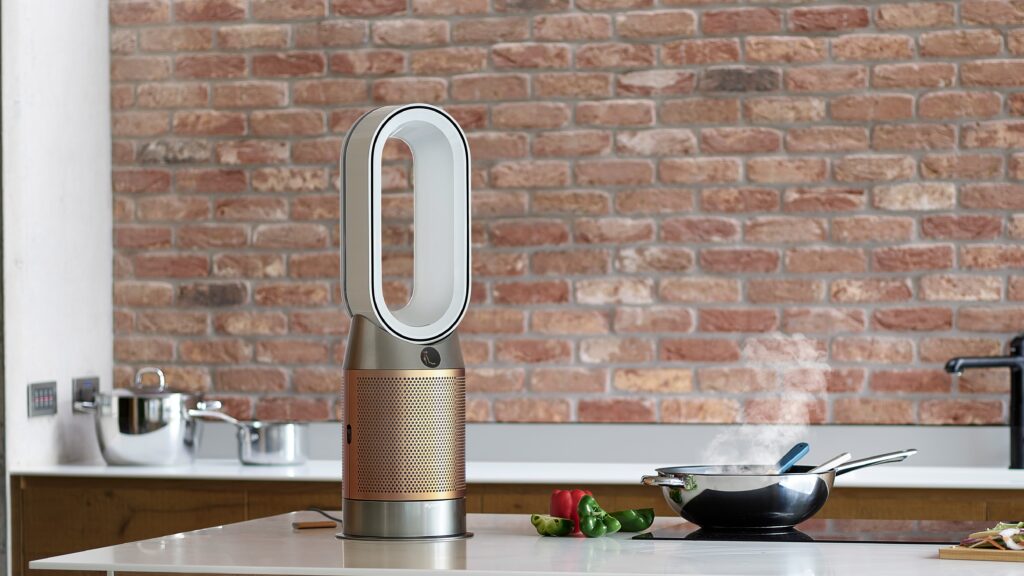
If you are in the market for a new air purifier for your home and have done even a little bit of research then you must have already realized that Dyson air purifiers are the best in the market.
While considering which air purifier to buy, if company histories are anything to go by, Dyson is 30 years old. It was founded in the UK by Sir James Dyson in 1991 who got frustrated by his old vacuum cleaner and set out to invent new technology to build the best vacuum cleaner in the world.
In his search, he invented the cyclonic separation technology that is behind all the bagless type vacuum cleaners in the market today. Today, the Dyson company manufactures household appliances like air purifiers, vacuum cleaners, bladeless fans, and hair dryers.
One of the most notable aspects of this company is that it invests close to $10 million a week in product development. It’s a part of its identity. After all, sir James Dyson’s inventions won him multiple awards and accolades.
He even founded the James Dyson Foundation to inspire a new generation of design engineers.
Despite its rich history of innovation and genuinely revolutionizing technologies behind every product, many potential customers still wonder why Dyson air purifiers are so expensive?
The answer can be found in the Dyson technology itself. Read on to find out how Dyson air purifiers work and differ from others on the market.
We’ll also explain how Dyson tests their air purifiers in their labs, in a way that perhaps no other company does. And, why Dyson products do not conform to industry-standard tests like CADR etc. Feel free to skip to the appropriate section with the quick-click navigation panel below.
- Understanding Dyson Air Technology
- Defying Conventional Testing Standards
- 4 Best Dyson Air Purifiers in India: At a Glance
- 4 Best Dyson Air Purifiers in India: Detailed Reviews
Understanding Dyson Air Technology
You know, how IKEA stands for customizable and affordable furniture and how Apple stands for user experience? Dyson stands for truly multifunctional technology that works efficiently for the home.
A Dyson air purifier is not just an air purifier, it is an air purifier as well as an air multiplier in one. And that’s just the Dyson Cool link tower.
The Dyson Hot + Cool air purifier is an air purifier, a heater, and an air multiplier in one.
Dyson believes that you could use three standard products in your home to perform three separate jobs or use one good one that melds these three functions efficiently.
And, ‘efficiently’ is the key here. You see, creating a piece of product that has two separate functions is easy but to do it synergistically is the difficult part.
To understand what this means, let’s break down how the Dyson air purifier works.
360-Degree Glass Dyson HEPA Air Filter


Dyson air purifiers have a tower design.
There are primarily two types of designs in air purifiers: the tower and the flat type.
The flat type goes against the wall, and the tower design is meant for larger, non-clearly defined spaces with a lot of air channels.
In the tower design, the air is taken into the air purifier from the base from all sides i.e., 360-degrees. The air that is taken in then passes through the glass HEPA filter from Dyson.
HEPA stands for ‘High-Efficiency Particulate Air’ filtration. It is a mechanical form of filtration that utilizes the movement of the air through the filter surface to trap suspended particulate matter instead of relying on chemical or electrical processes.
The HEPA filter is made of densely packed paper with randomly distributed fibers that catch the pollutants like a sieve. This is why the efficiency of any HEPA filter lies in its pleats and folds.
The larger the surface area of the filter the more potential there is for trapping harmful pollutants in the air. The Dyson air purifier HEPA filter is pleated over 200 times and ensures that 99.95% of particles as small as PM 0.1 are removed from the air. Moreover, it is peppered with borosilicate to further enhance its efficacy.
Also, the carbon filter is TRIS coated. The coating allows it to absorb harmful gases like formaldehyde more effectively and also extends its life.
Air Multiplier Technology
So, the air gets pulled into the air purifier by the impeller, passes through the glass HEPA filter, and rather than being thrown out into the room is projected into the annular loop. The loop is the hallmark of Dyson’s air purifier design.
This is where the magic happens. The small curvature in the opening of the air purifier’s loop works in the same way that the wing curvature of an aircraft does.
While the wing curvature causes the airplane to take off, the curvature of the opening of the air purifier’s loop creates negative air pressure. This negative air pressure then draws more air from the surrounding areas.
The effect is that the airflow goes up by about 16 – 18 times! This is the air multiplier technology and it results in a cool gentle breeze of purified air rather than the choppy slapping of a fan.
In this manner, the air purifier also works as a very safe bladeless fan for your home.
The loop is oscillating of course so the direction of the airflow can be manipulated as per convenience. And it is much easier to clean than a standard blade fan.
The Dyson Hot + Cool air purifier boasts of the added heating function. Within the loop are positive temperature coefficient ceramic plates that get heated up to your desired temperature.
As a result, the air is heated within the loop before being projected out. The plates stop conducting electricity after a particular temperature to avoid any chances of overheating.
Effective Monitoring
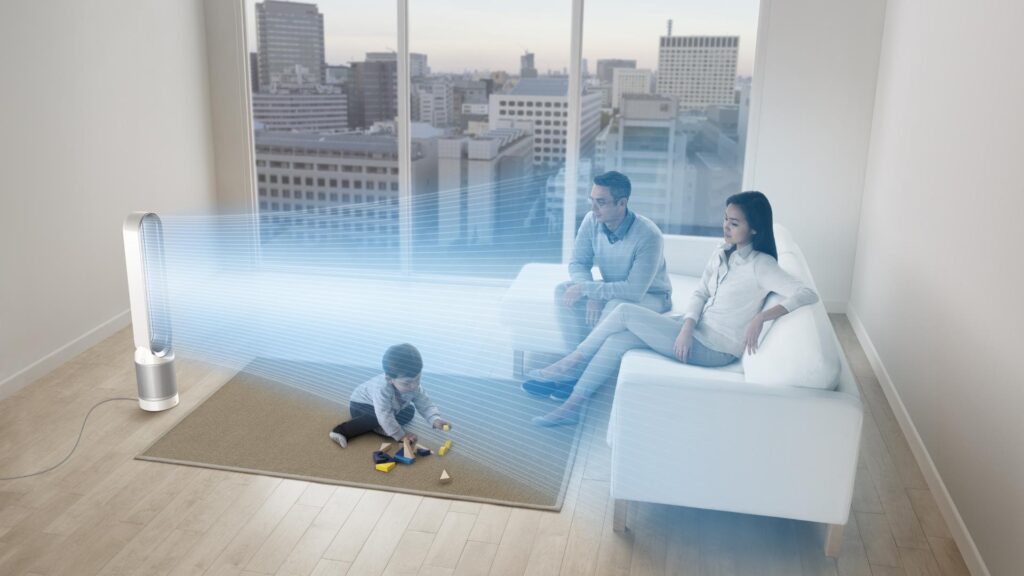

That is the purifying and the air projection functions. But to clean effectively the device has to be able to monitor the air quality effectively too.
Accurate monitoring allows air purifiers to adjust and recalibrate their function to suit the changing AQI in the room.
Think of it this way. An air purifier that does not adjust to the changing air quality in the room and continues working at one set mode not only consumes more power but can be detrimental to the room’s air quality.
For instance, such an air purifier will continuously stir up unwanted air currents in the room that may kick up the settled particulate matter.
To counter this, Dyson has a very sensitive and sophisticated air quality monitor that links to the Dyson Link App. The air purifier constantly monitors and adjusts accordingly, to keep the air quality within your desired parameters.
Multiple parameters of AQI are reflected in real-time within the Dyson Link App and you can pretty much control any aspect of the air purifier from it.
Why Are Air Purifiers from Dyson So Expensive?
What makes an air purifier expensive?
In fact, what makes any product expensive?
The first and foremost factor should be that it’s highly effective at doing what it’s aimed to do.
Meaning if you are looking at an air purifier then it should be really effective at cleaning the air of pollutants, particulate matter, and harmful gases.
Also, it should be consistent performance-wise.
Customers would like that the air purifier performs effectively not just in lab conditions but also in real-world scenarios. And real-world conditions are constantly changing so the performance has to be dynamic and adaptive to ever-changing situations.
For an air purifier, this would mean that it performs consistently in cleaning the air under different and ever-changing AQIs.
Secondly, you could look at the level of technology in the product. The better and more advanced the technology, the higher the price of the product. If there is more than one technology, that could also increase the price of the product as well.
For example, Bluetooth headphones are more expensive than wired headphones as they have to integrate Bluetooth and audio technology.
Third, the life of the air purifier and post-sale support must be considered too. Generally, products that last longer tend to have a higher initial cost. Look at O’General air conditioners or even iPhones.
When it comes to performance, Dyson air purifiers have 360 degrees sealed glass HEPA filters and TRIS coated carbon filters that capture 99.95% of particles as small as 0.1 microns.
The key here lies in the ‘360 degree sealed’ part as a lot of air purifiers on the market also promise the rest. Let us explain.
The Dyson air purifiers have a tower design. Tower design air purifiers have round-shaped HEPA filters as opposed to the flat types. This means that air is drawn uniformly across the surface of the HEPA filter. In flat-type air purifiers, the air is usually drawn in from side channels.
Open a flat type air purifier and you will notice dust channels developing on the inside surface of the covering panel matching the air channels. This causes pockets of HEPA filter to be used and a decreased life of the HEPA filter as well.
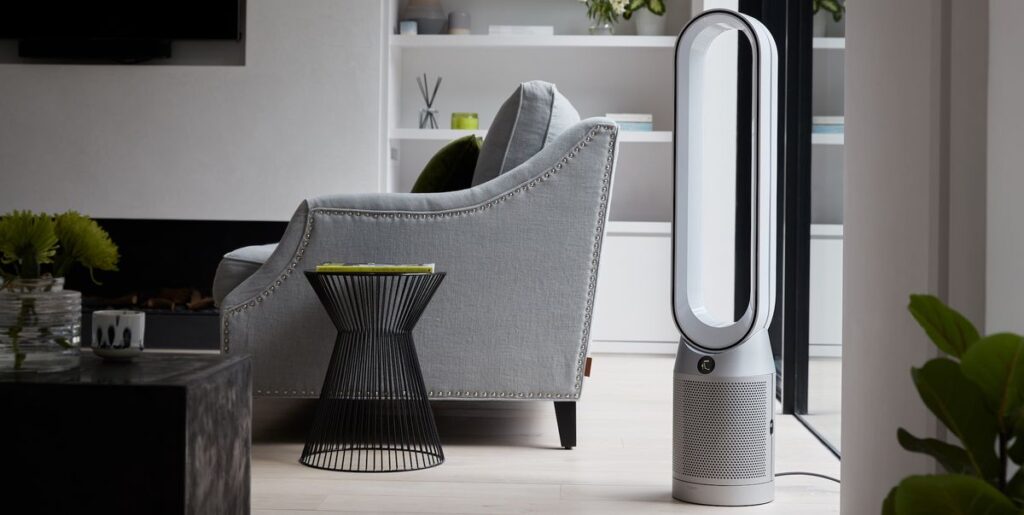

The uniform distribution of air across the Dyson HEPA filter means more effective usage of the surface of the filter.
Another factor to consider when you’re dealing with particulate matter, it really does not matter how well you catch them unless you can keep them there. Any caught particulate matter, dust or mites or mold spores can escape easily if the product is not a ‘sealed system’.
A lot of the air purifiers on the market, even though will promise you removal of 99.99% particulate matter, will often lack this sealed system. Any caught allergens or microbes can readily escape back into the indoor air and can be the cause of allergies and breathing difficulties.
Further, depending on which Dyson air purifier model you choose, you will always get more than one product technology.
Meaning a Dyson Cool Link tower air purifier will give you an air purifier plus a bladeless fan. A Dyson Hot + Cool air purifier will give an air purifier, plus a bladeless fan, and a heating system for your room as well.
At this point, it is pertinent to mention that while it may seem absolutely trivial to say that it is an air purifier plus a fan plus a heater. What most people miss is that these added features actually build on top of each other.
When you have a really effective HEPA filter in the room but no way to ensure proper circulation, air pockets of unclean air develop.
The air multiplier technology which we are here referring to as a bladeless fan actually ensures that there is proper circulation of air around the room, no matter how it is shaped.
This also ensures that the entire volume of indoor air gets purified faster. In effect, the air multiplier technology compliments, the HEPA filtration, and the level of performance of the product become more than the sum of its parts.
Another way in which Dyson proves its ability to meld technologies together is how it tests indoor air quality and dynamically adjusts to it. Dyson air purifiers turn out to be superior because first, they test the AQI accurately, then purify it efficiently.
The superior glass HEPA filtration in a Dyson air purifier in this manner gets complimented and augmented by the monitoring as well as the air multiplier technology.
Another way to look at this is that any system is only as good as its weakest link. And with a Dyson air purifier, there are no weak links.
The accurate monitoring makes for effective filtration, and the air multiplier technology makes sure that the filtration is consistent by enhancing airflow. In the case of the Dyson Hot + cool air purifier, the heating function also integrates with the air purifying technology.
The best part about all this is that when technologies are truly in sync, the power consumption drops, there is low noise, chances of wear and tear decrease, and the life of the HEPA filter and the whole product itself increases drastically.
Defying Conventional Testing Standards
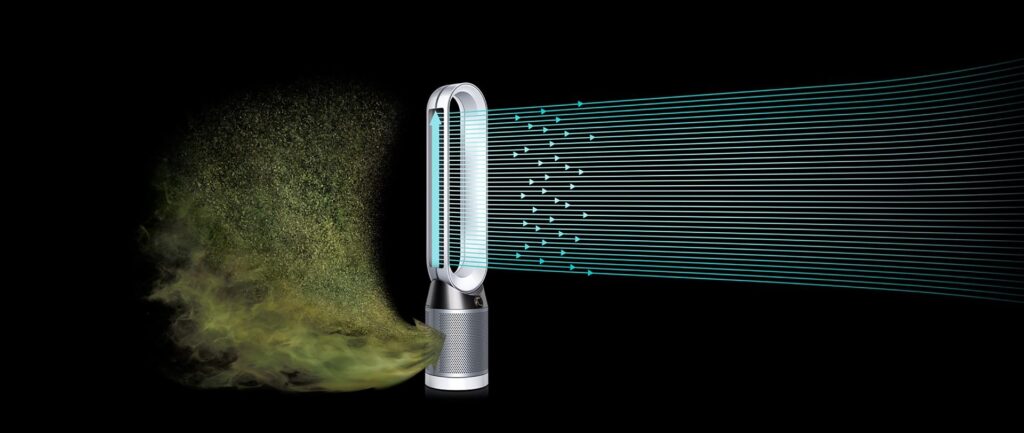

You might be thinking that if Dyson technology is so superior then it should be reflected in its CADR.
After all, CADR is the industry standard test for comparing the efficacy of air purifiers, right? Well, not exactly.
Let’s understand what CADR is, how it’s measured, and why you can’t find one for Dyson air purifiers.
What Is CADR?
CADR stands for ‘Clean Air Delivery Rate’.
It is an industry-standard test that gives its results in terms of CFM or Cubic Feet per Minute.
An air purifier with CADR of 300 delivers 300 cubic feet of clean air per minute. Therefore, the higher the CADR the higher the efficacy of an air purifier.
Why Dyson Air Purifiers Don’t Show CADR?
Dyson air purifiers do not reflect a CADR rating as Dyson does not test its air purifier’s CADR. The company believes that CADR is an ineffective measure of how well an air purifier will perform out of lab scenarios.
There are a few reasons for this too.
For example, CADR is measured in a small empty chamber. There are fans above to circulate the air and the test runs for 20 minutes at the highest speed available for the particular air purifier being tested. However, there are a few drawbacks to conducting this test.
- Firstly, the chamber is way too small to be even close to the size of a normal room.
- Secondly, the small testing time is unindicative of how well the air purifier performs in the long run.
- Thirdly, the air purifier’s CADR is measured only at full speed.
This means that at lower speeds it may not deliver the reflected CADR at all. Further, there is just one sensor measuring the AQI, and CADR only tests for three things: dust, pollen, and tobacco smoke.
However, there are many other types of pollutants in the indoor air and often VOCs are found in dangerously high levels indoors.
Dyson’s POLAR Test
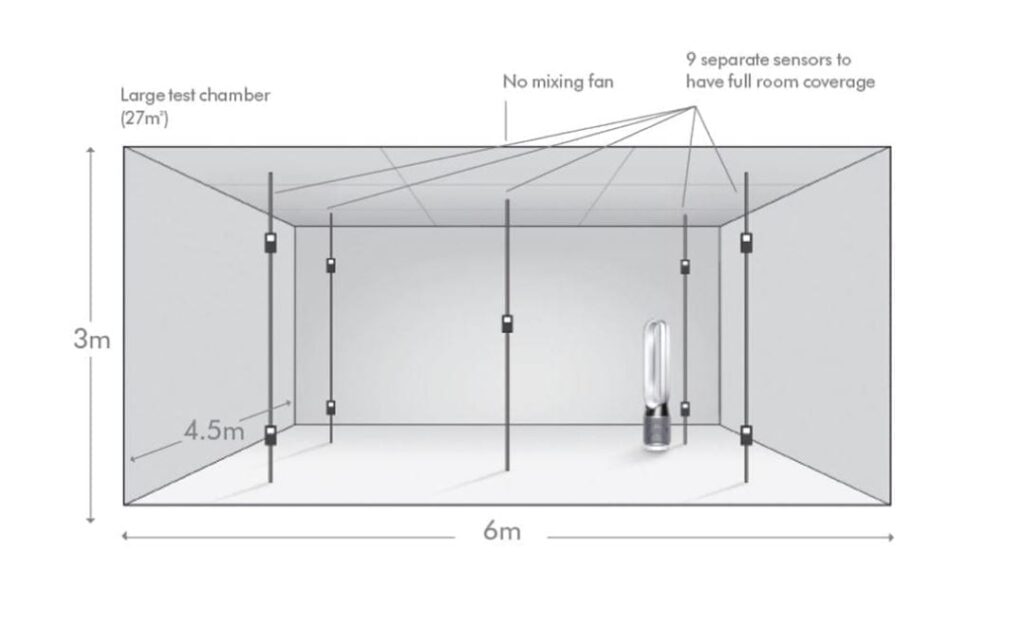

While the air purifier technology has improved significantly since the first air purifiers hit the market, the standard test for comparing them hasn’t.
As a result, the CADR test was developed in the 1980s and continues to be the benchmark even today.
To tackle the drawbacks of measuring the performance of an air purifier by its CADR, The POLAR test was developed by Dyson scientists in 2018.
POLAR stands for ‘Point Loading and Auto Response’ test. This test evaluates accurately the true performance of an air purifier in a real home-like setting.
It differs from the CADR in several respects.
- First of all, in this test, the chamber size is much larger than the one used for CADR tests. It compares to an average-sized room and does not have any fans on the ceiling or walls.
- The air purifier is not placed in the center of the room and is instead placed on the side. With these settings in place, we can see the true performance of a purifier in conditions that accurately imitate real-world scenarios.
- The air quality is tested with 9 different sensors that are distributed around the room.
- Further, the sensors test for 5 types of particles and 11 gases as opposed to just 3 particles as in the case of CADR. The sensors spread across the room challenge and test the air purifier’s capability to not only purify the whole room but also to detect AQI accurately.
After all, if the air purifier cannot detect subtle changes in AQI accurately then how will it effectively purify the air on its AUTO setting? Which is what most of the users rely on. All Dyson air purifiers are tested like this and that is the standard of performance that Dyson promises for all its air purifiers.
Still, there are quite a few models and they do differ in significant ways. Read below to find out the differences and pick the best one for your home.
4 Best Dyson Air Purifiers in India: At a Glance
Product Name | Technologies | Price Segment | Price |
Air filtration Air cooling | Cheap | ||
Air filtration Air cooling | Affordable | ||
Air filtration Air cooling | Expensive | ||
Air filtration Air cooling Air humidification | Expensive |
4 Best Dyson Air purifiers in India: Detailed Reviews
1. Dyson TP03 Purifier (Cool Link Tower)
Editor’s Rating: 9/10
Despite being one of the oldest models, if you want to bring home a piece of legendary Dyson technology on a tight budget, the Dyson Cool Link Air Purifier is the place to start.
This model is one of the cheapest Dyson air purifiers in the market since it was one of the first models that were introduced in the Indian market by Dyson in 2018.
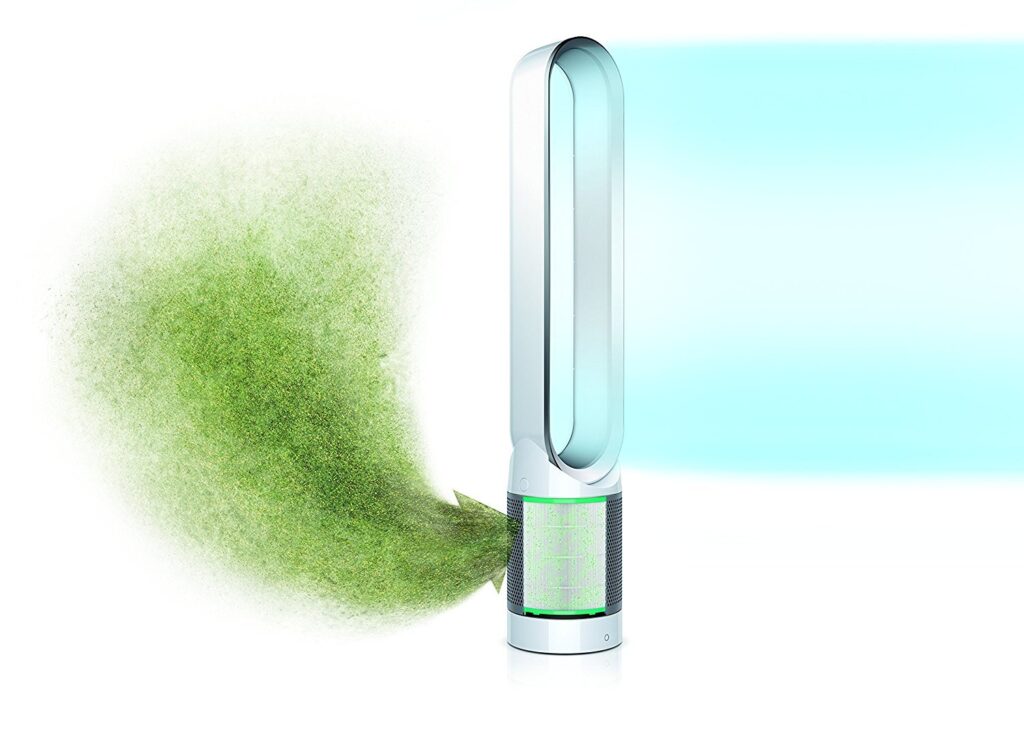

Its best feature is the high-efficiency 360-degree glass HEPA filter with a TRIS coated carbon filter. It effectively removes 99.95% of allergens as well as pollutants as small as PM 0.1 (0.1 microns) including dust, pollen, mold spores, bacteria, pet dander, VOCs, and other harmful gases/odors.
The TRIS coating on the carbon filter increases the surface area of the carbon molecules and makes them 70% more effective.
The best part of this air purifier is the sealed system. When you are dealing with particles in microns, capturing them becomes important but keeping them is the key. If the system is not sealed any captured particles can escape back into the indoor air and become a cause for allergies. That is not a concern with this product.
With the air multiplier technology, you not only ensure proper and thorough air circulation for maximal purification but also fulfill the function of a fan which is a necessity in Indian homes.
Only, this fan is bladeless, projects air like a cool breeze rather than violent chopping, is easier to clean, and is safe in case you have children or pets at home.
In the winter months when you do not require the cool draft just put it on the diffused airflow mode and the purified air will escape out the back without causing a drop in the air temperature. The air projection is customizable with 90 degrees oscillation which allows this device to cover a large area.
There are two sensors in this air purifier that continually monitor the indoor AQI. This makes the auto mode on this product very efficient as it adjusts the airflow in relation to the most subtle changes in AQI caused by the opening of doors and the movement of people.
The changing AQI and selected settings are displayed continually in the Dyson Link App. Here you can schedule your air purifier around your routine as well or control it remotely as per your convenience. There are ten fan speed settings, nighttime mode, and a sleep timer that covers all bases.
If you prefer the control through a remote instead of your phone, there is that option as well. The remote control is magnetized and fits snugly on top of the machine. The air purifier is voice-enabled and is compatible with Amazon’s Alexa and Google’s Voice Assistant making it even more convenient.
This product is certified by the Asthma and Allergy Foundation of America (AAFA) and comes in white/silver color with a 2-year warranty. Even though this is the cheapest Dyson air purifier, it is a contender among the highest performing air purifiers of other brands.
Who’s it for: For those looking to purify large spaces without compromising even a little bit on the quality of air purification.
Tech Specs | Pros | Cons |
|
|
|
2. Dyson TP07 Pure Cool Link Air Purifier
Editor’s Rating: 9/10
This Dyson air purifier is an upgrade on the Cool Link tower and comes with everything that the Dyson company stands for and then some.
The first and foremost upgrade is the HEPA filter itself. Like the previously reviewed model, this one also promises to remove 99.95% of the pollutants as small as 0.1 microns.


However, this model specifically mentions that its HEPA filter is H-13 grade. Combine that with the patented TRIS coated carbon filter and you have a combination that effectively cleans the indoor air of particulate matter, pollutants, gasses as well as dust mites, and mold spores. Odors are very effectively removed with this machine as well.
The sensor automatically senses and displays four parameters in AQI: PM2.5, PM10, VOCs, and NO2. This data is available in the Dyson Link App and is updated every 12 seconds.
Further, the detected AQI is also displayed on the machine in a 24-hour graph in real-time. This feature is not available with the previously reviewed model.
Another improvement over the Dyson Cool Link tower is that here you can customize the oscillation of the air projection to up to 350 degrees as opposed to 90 degrees.
This feature will be particularly helpful in irregularly shaped rooms where the purifier may not be placed in the exact corner but somewhat in the center of the room. L-shaped and T- shaped rooms particularly benefit from this feature.
There is a diffused airflow setting that redirects the air out the back and does not produce a draft of air in the room. This setting just purifies the air without cooling the room. A much-needed feature for the Indian setting where the pollution is highest in the winter months.
There are 10 speed settings in this model too that are accessible from the Dyson Link App. There is a sleep mode that dims the display for light sleepers and detects and purifies air in a quieter setting.
Another major upgrade with this model is that on the whole this product has been designed to be 20% quieter than its previous model. There were some complaints with the earlier model of there being too much noise at higher fan settings, with this one, there’s none.
Everything good is still there such as the sealed system, voice control with Alexa, and google home integration along with remote control option as well.
The magnetized remote control still sits pretty on the machine, you will never lose it. But we don’t understand why in this one the cord length is slightly shorter. Perhaps this one is not meant to be moved around so much.
Nevertheless, it is certified allergy and asthma-friendly and comes with a 2-year warranty. It also comes in a variety of colors like white/silver, black/nickel, and an Iron/blue color combination. Take your pick.
Who’s it for: If you want complete control over your indoor air and don’t mind paying a little extra for it, this one is for you.
Tech Specs | Pros | Cons |
|
|
|
3. Dyson HP07 Purifier (Hot + Cool)
Editor’s Rating: 9/10
For everyone living in the northern part of India, pollution is a major concern in the last quarter of the year. Almost every house needs an air purifier to deal with the deteriorating AQI in these months.
Since these months also happen to be the coldest months of the year, it just makes sense to add the heating component to the air purifier, doesn’t it?
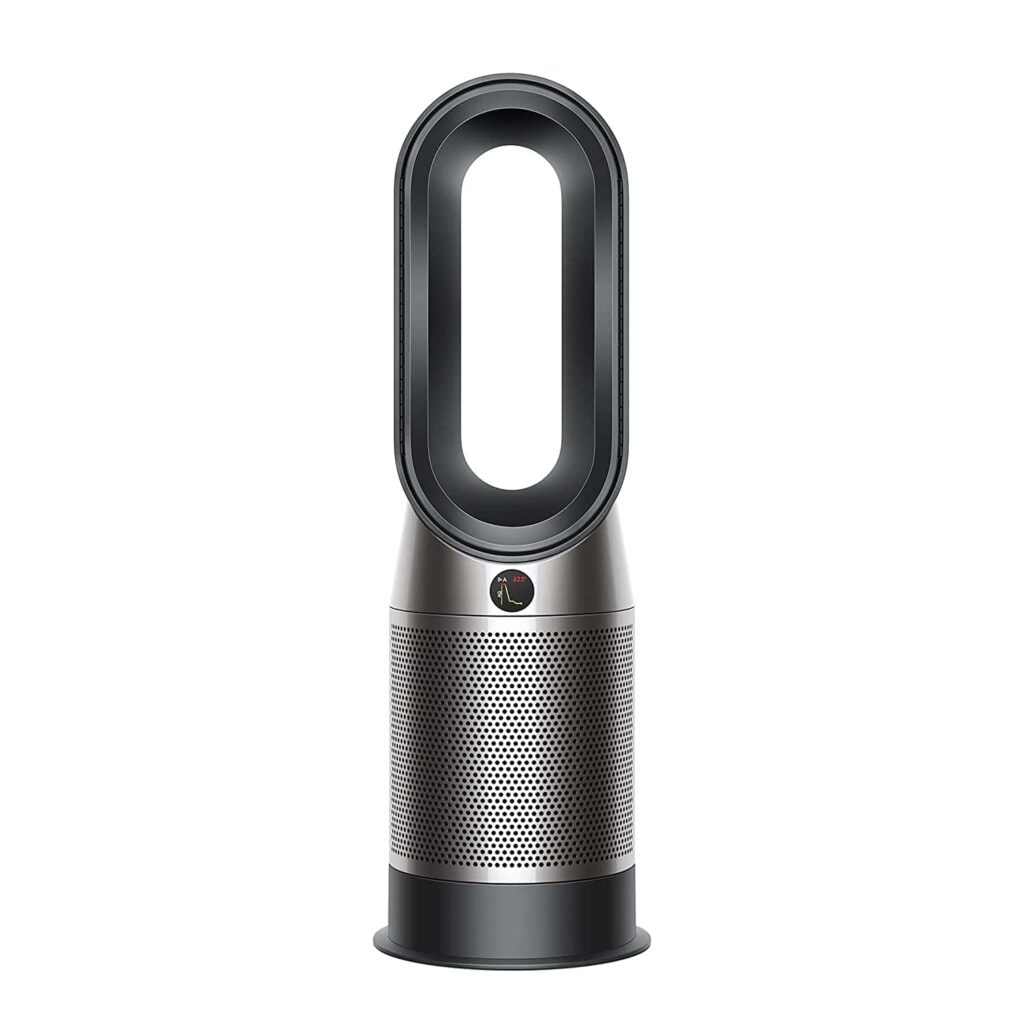

Well, if it was so easy every company would be doing it but the Dyson Hot and Cool air purifier is the only one on the market that has the capability to purify, heat, and cool the air.
Dyson is not called the master of manipulating air for nothing. Still, the most important part of this product remains the air purifying technology, so let’s talk about that.
The best part about Dyson products is that they never cut corners. Every product houses its best technology. So even with the Dyson Hot and Cool purifier, the air purification is done with the patented H-13 grade 360-degrees glass-sealed HEPA filters accompanied with the TRIS-coated carbon filter. This is the most advanced grade of HEPA filtration and effectively cleans the room of 99.95% of particles up to 0.1 microns.
With the air quality and purity sorted, let’s turn our attention to how it fares as a room heater. Often, when we try to use a room heater and an air purifier at the same time, their individual effects of each end up minimizing the total overall effect.
The total overall effect we are looking for is absolutely purified as well as heated air that is consistently distributed throughout the room while consuming the least amount of power. That’s called efficiency.
However, what ends up happening is that in most cases the air purifier is projecting the air upwards. And the heater is also projecting the air upwards, as warm air rises. This creates pockets of air in the room that are neither clean nor warm. Meaning there is inconsistency.
To combat this, the heater works on the max capacity to reach the desired temperature, and the air purifier, if on auto mode, works on max speed too to restore good AQI levels. This means consumption of maximum power for both. This is inefficient.
This does not happen with the Dyson purifier (Hot and Cool). The air is purified in the sealed HEPA filter and then projected into the annular loop where ceramic positive temperature coefficient plates heat the air before it leaves the annular loop. These plates stop conducting electricity as they reach the higher desired temperature, so there is absolutely no fear of overheating.
Further, the warm air is properly circulated throughout the room so that there are no cold pockets and the entire room is heated faster. When technologies are in sync there is an efficient use of power.
The air purification system of the Dyson Air Purifier (Hot and Cold) works without the heating as well. In the summer months when the heating function is not required, the bladeless fan works well to cool the air and if you do not require a draft of air, just put it on the diffused mode.
All the features that you will find in a standard Dyson air purifier are still there. It is Wi-Fi enabled and displays AQI reports in the Dyson Link App. It can be scheduled from the app as well.
There is a sleep mode, 10-speed settings, and it is voice-activated as well as remote-controlled. There is a display on the unit that displays in real-time the AQI levels in the form of a graph. Finally, it is certified allergy and asthma-friendly and comes with a two-year warranty.
Who’s it for: If you have a well-sealed space, are a fan of clean air, and often require room heating there is simply no other product on the market that can perform both functions with more ease and efficiency.
Tech Specs | Pros | Cons |
|
|
|
4. Dyson PH01 Purifier (Pure Humidify + Cool)
Editor’s Rating: 9/10
North India has one of the driest summer months. This dry weather coupled with pollution is a cause of major breathing difficulties and allergies for many.
Humidifiers are a great solution for many people and often work very well to keep the indoor air moist. However, humidifiers can also be a cause of bacterial growth as microorganisms love humidity.
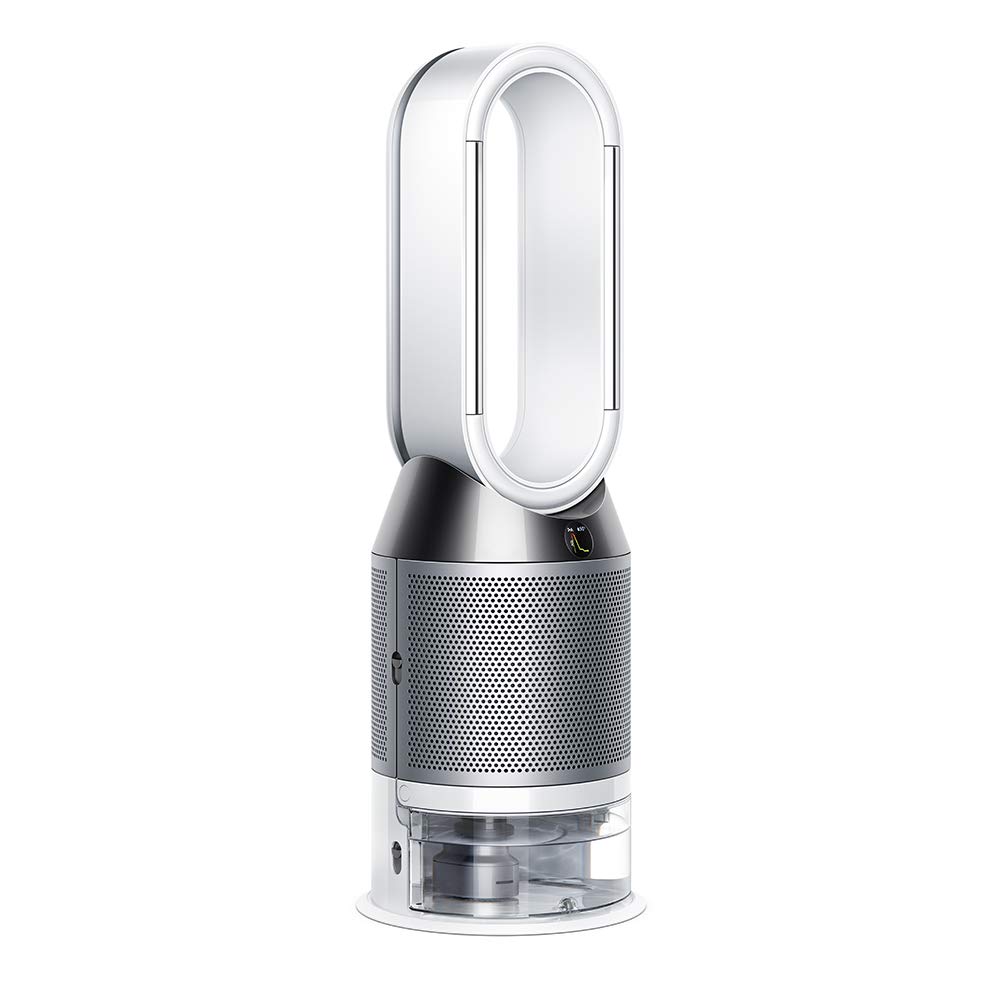

To combat this, Dyson manufactured the Humidify + Cool air purifier that not only cleans your air of the particulates but also maintains the humidity levels in the indoor air hygienically.
The air is purified with the H-13 grade 360-degree sealed-glass HEPA filter and TRIS coated carbon filter that removes 99.95% of all particulates up to 0.1 microns in size.
The humidifier compartment before releasing the water vapors to be mixed with the clean air exposes it to ultraviolet C light. This effectively sterilizes the water vapor and kills any existing bacteria as well as prevents any chances of bacterial growth within the filters.
This is critical as the people with breathing sensitivities who need the humidification the most are also the ones most bothered if there is any bacterial growth on the filters. The indoor air then effectively becomes toxic and can potentially cause a range of problems. With the Dyson air purifier, this is never a problem.
After humidification, the clean moist air is circulated throughout the room maintaining effective levels of water vapors in the indoor air. Moist air also feels cooler in the summer months. The humidification feature can be turned off if not required.
In this Humidify + cool air purifier there are three modes of airflow projection. There is a new breeze mode that varies the airflow to mimic a breeze, there is the standard straight air fan mode and there is the diffused mode for those times that you want only purification without a draft.
All the other features are still there. There is a display on the machine with a real-time graph of recorded AQI that is updated every few seconds. The air purifier is Wi-fi enabled and the AQI reports are also available in the Dyson Link App. The app will not only let you control the settings and set a schedule but will also let you know if the water chamber is empty and needs refilling.
The machine requires deep cleaning of the evaporator at regular intervals depending on the hardness of water dispensed in it. The Dyson Link App lets you know when it’s time to run a deep clean cycle. The product is voice-enabled and integrates easily with Alexa as well as Google Voice Assistant.
All the features come at a price though, and this is one of the most expensive Dyson air purifiers in the market right now. Still, for those who like their indoor air perfect, in every manner, it’s a no-brainer.
Who’s it for: If you have people in your family that suffer from breathing sensitivities or allergies this is the one for you.
Tech Specs | Pros | Cons |
|
|
|
Contents



